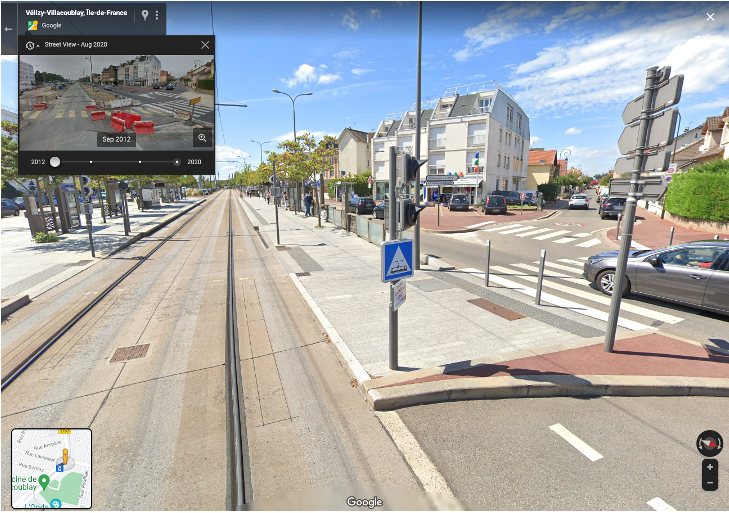This article is focused on aspects of Eno’s latest report: Saving Time and Making Cents: A Blueprint for Building Transit Better. For more information about right-of-way decision-making, register today for Eno’s Transit Cost and Delivery Symposium on October 18-21, 2021. At the event, we will share findings from Eno’s transit cost and delivery report, and include panel discussion on best practices in project standards and other project delivery themes among transportation professionals, policymakers, and researchers.
When building new transit lines, planners have to balance serving the most number of people within the budget confines of a project. Eno’s recent report on transit project delivery found that rail transit project costs in the U.S. are nearly 50 percent higher than similar international projects, despite international projects often weaving through dense commercial and residential centers. Countries abroad are getting more bang for the same buck as our low cost routing options. In the U.S., higher project costs, finite financial resources, and a desire to minimize disruptions to local communities often leads projects sponsors to place rail lines in highway medians or other existing right-of-way. This approach, however, can fail to provide the best “bang for the buck” and often results in transit lines that miss key population centers.
Why do project sponsors opt to place rail alignments in existing right of way?
Using existing right-of-way can be an attractive option to simplify decisions on projects that are otherwise complicated, expensive, and require significant time, money, and coordination to build. Processes like land acquisition and utility relocation that come with obtaining new right-of-way (ROW) are often cited as sources of delay. Anecdotal evidence from a 2019 GAO report suggests that the costs of ROW acquisition are closely correlated with local land values, and that many project sponsors use existing ROW, such as highway medians, to avoid costly and time-consuming land acquisitions.
The U.S. case studies we evaluated for our research – Los Angeles, Denver, Seattle, Minneapolis, and Virginia I-495 HOT lanes and Silver Line extension – all feature examples of light or heavy rail lines that were routed on existing right of way.
How opting for the cheapest alignment can inhibit transit accessibility
Routing transit through existing right-of-way may help agencies keep project costs low, but can undermine their ability provide accessible, widely used transit service. Ridership is just one metric that assesses transit accessibility. In order to meet ridership goals, though, transit needs to be accessible to those who are likely to use it. The image below, for example, depicts a rail line built through existing right-of-way in Antioch, CA as part of the eBART extension that does not serve an optimal number of potential riders because of its distance from key population and activity centers. The line cost $60 million per mile to build.
eBART: 2007

eBART: 2021

In contrast, the below set of images shows how the T6 Tram in Paris, was built in on top of a decked over roadway in a dense urban environment. The T6 was built at a cost of $62 million per mile.
T6: 2012

T6: 2020

If lines are not routed near housing, commercial centers, or other services, or if there are no plans to modify land use around new stations, then transit is not serving its intended purposes. By trying to pre-empt the short-term cost problem, project sponsors instead create separate long-term problems where transit is underutilized and, consequently, not viewed as the community-serving mobility resource that it has the potential to be.
In contrast, the international examples explored in our research include trams constructed underground in dense, historic city centers, or at-grade in the median of existing arterials by taking lanes from cars. These projects are delivered at a similar cost to U.S. projects that choose a path of less resistance but provide far more utility and benefit to their communities because they serve places people want and need to go.
In attempting to build in the path of least resistance, both to minimize costs and to avoid public pushback against construction disruptions, project sponsors undermine the potential of transit to deliver real mobility solutions. To maximize public benefits, project sponsors should think critically about the tradeoff between cost and access, and strive to make the case for why transit is a good investment and adopt the mindset of achieving accessibility goals.
The good news is that project sponsors don’t have to be reliant on highway medians and freight rail ROW; at the same time, projects can be delivered with lower costs based on evidence from Europe and elsewhere. To make that happen, these are a few related recommendations from our report that can empower agencies to make better projects at lower costs:
- Agency staff need to be more empowered to make tough decisions on project scope and requests
- Policy and practice reforms are needed to address significant shortcomings related to utility relocation and land acquisition.
- The federal Capital Investment Grants program needs to require minimum zoning densities or level of development around stations as a condition for federal funding. Similarly, federal evaluation needs to de-emphasize ridership as a key component of a project’s success and rely on accessibility metrics more often.
- Project sponsors should work with the community to recognize trade-offs and push for greater short-term disruption to advance construction faster.
This article is focused on aspects of Eno’s latest report: Saving Time and Making Cents: A Blueprint for Building Transit Better. For more information about right-of-way decision-making, register today for Eno’s Transit Cost and Delivery Symposium on October 18-21, 2021. At the event, we will share findings from Eno’s transit cost and delivery report, and include panel discussion on best practices in project standards and other project delivery themes among transportation professionals, policymakers, and researchers.







